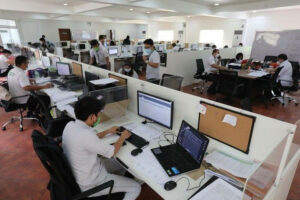ARTIFICIAL INTELLIGENCE (AI) adoption in the Philippines has gained ground and will continue to grow, driven by the country’s young and skilled workforce, according to technology consulting firm Searce.
However, regulators and companies must put in place various safeguards to ensure the responsible use of AI-driven technologies.
“There is traction in the adoption of AI for sure, and the Philippines is at a slight advantage in AI adoption compared to its regional and global counterparts. One major strength is our human capital, with over 700,000 STEM (Science, Technology, Engineering, and Mathematics) graduates produced annually and a leading outsourcing industry of approximately 1.3 million workers. Government support, highlighted by the 2021 National AI Roadmap, outlines strategies for integrating AI across various sectors,” Ferdi Saputil, Searce country director for the Philippines, said in an e-mail.
“We stand out in Southeast Asia with an open cloud policy, unlike Vietnam and Indonesia, which impose stricter data localization laws. This openness fosters broader access to cloud services and innovation. Additionally, our youthful population, with a median age of around 25, quickly adopts technology, evident in the rapid growth of fintech companies,” Mr. Saputil added. “While Singapore leads in government investment and regulation, it faces higher costs and a smaller talent pool compared to the Philippines. Although Vietnam excels in math education, the Philippines benefits from better English proficiency and service-oriented capabilities.”
To build on these competitive advantages, the Philippines must improve its internet infrastructure and data protection frameworks, he said.
There are also concerns about brain drain among top tech talent in the country, Mr. Saputil said.
“Addressing these issues while leveraging our strengths will be essential for advancing AI adoption in the country,” he said. “In the coming years, there are significant opportunities for growth and innovation as AI integration becomes more critical.”
According to Searce’s 2024 State of AI report, 51% of companies still fall short in their AI adoption due to managerial and cultural barriers. Some 41% of firms have also been held back by technical limitations like insufficient infrastructure and expertise.
These highlight the importance of building an AI-driven culture among organizations, Mr. Saputil said.
“Organizations often resist change due to a lack of understanding of AI and its benefits. Additionally, decision-makers may be hesitant to invest in new technologies without a clear understanding of the return on investment. To address these barriers, companies need to foster a culture of education and practical usage around AI, improving managerial understanding and encouraging open communication about the benefits of AI adoption,” he said.
“Many organizations are also battling with perceptions that AI will replace humans and displace jobs, when in reality, it’s about utilizing AI to enhance the work that humans do, and which can then elevate their roles towards more value-added tasks. Ultimately, the transformation mindset must shift from “AI is doing this” to “AI helps me do this,” signifying a deep-rooted cultural adaptation that will drive AI adoption forward and allow firms to fully realize its potential in enhancing their business operations.”
Philippine enterprises should also consider adopting a hybrid approach to AI adoption or using proprietary tools for general applications while tapping AI for specialized functions to allow them to customize these technologies according to their needs, Mr. Saputil said.
Having strong regulatory and governance frameworks will be key for responsible AI deployment in the country, he added.
“Moving forward, the Philippine government should consider introducing regulations that enforce data residency requirements and establish mechanisms for mapping and tracking the flow of information. Moreover, implementing technical safeguards to prevent unauthorized cross-border data transfers is essential, particularly when organizations are using various AI services to train their models. By putting these measures in place, firms can build a robust, compliant AI ecosystem that reassures users and stakeholders alike.” — Beatriz Marie D. Cruz
